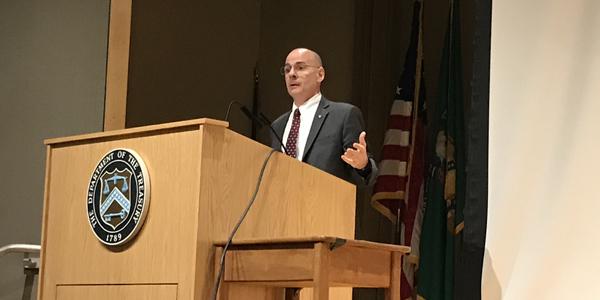The Internal Revenue Service Battles the Procurement Beast
For an agency that awarded $2.5 billion in contract obligations in fiscal year 2017, the Internal Revenue Service (IRS) is a big player in federal procurement. And as the IRS begins to implement the major tax reform mandated by the Tax Cuts and Jobs Act passed by Congress in late December, not to mention handling federal information technology modernization efforts, the agency is tackling another challenge: procurement improvements.
The IRS understands that any improvement in procurement efficiencies will help the agency in terms of increased competition in bidding and driving down prices, while providing more innovative solutions for its internal customers who are carrying out the IRS’ mission, according to officials.
The agency is not funded or authorized to do all of its taxpayer work by itself and must rely on contractors, Harrison Smith, IRS deputy procurement officer, told reporters at the agency’s Reverse Industry Day on April 4. “The industry are our partners and we can’t do the work without them, so we must engage with them the best we can,” Smith noted.
As part of the effort to boost acquisition processes, the agency is focusing on improving education from within the organization—including revamping antiquated policy manuals—as well as increasing engagement with industry. “We are really working hard on increasing our transparency with industry as well as having robust training events for our folks,” said Shanna Webbers, the agency’s chief procurement officer. For Webbers, the IRS’ effort to improve its acquisition stems from the agency’s strategic plan, and aims squarely at changing the culture. In particular, Webbers is working hard to defeat the reputation, real or perceived, that incumbents have a hold on IRS contract awards.
“What we heard from industry in the past was, ‘to do business with the IRS, you have to do business with the IRS,’” she said. “That is one of the mantras that we have continued to let our staff know is not a perspective that we want with our industry partners.”
The agency’s second reverse industry day is a key focus of its improvement process. The event, attended by most of its procurement staff, with a few industry representatives on hand to give feedback to the IRS, was an effort to train the procurement staff, lift the veil of what companies go through in a bidding process and have IRS employees “really listen” to industry, Smith stated.
To Webbers, the event was a chance to have contract officers and other procurement officials see companies directly. “My preference is more of a face-to-face interaction,” Webber said. “I think there is a lot of value in having that face-to-face and creating that partnership. And having our folks not just be able to hear industry, but also ask them questions in what I’ll call a safe environment is really important.”
For those industry partners brave enough to come in and share their procurement experiences during the event, the message to the IRS was candid: not communicating effectively with industry is costly. Companies who can spend a minimum of $2,000 per page responding to a request for proposal (RFP) build in 5 percent to 12 percent in terms of risk—risk of the government not effectively communicating the requirements or solutions they are seeking to purchase.
For some companies, getting involved in proposal work begins two to three years before an RFP is released by an agency. Companies may spend $250,000 to $400,000 on each proposal effort. Because this level of investment may be the same whether it is a $200 million contract or a $25 million contract, the companies make careful “gate” decisions at every stage of the proposal as to whether or not to proceed “through the next gate.” The companies need clear information and details from the IRS at all stages. Companies may even decide to cut their losses halfway through a bidding process, if it suddenly looks unfavorable or information is not clear. “Losing a $200,000 investment is better than losing a $350,000 investment with a loss in the end,” one industry executive said.
In addition, industry wants the contract officers to understand how their actions affect the industry. Andy Bove, senior vice president, Converge Networks Corporation, warned the room of IRS contracting officers that one small change to RFP or request for information (RFI) documents could have unintended consequences. To industry, wording changes between versions of the draft RFP and the final RFP are viewed as messages. Companies spend hours with expensive experts scrambling to discern the meaning and how to respond. Even the simplest change, Bove said, could lead to hedge pricing, where companies are building in more risk costs.
John Roman, senior vice president, Camber Corporation, technical solutions group for Huntington Ingalls Industries Inc., emphasized how important the list of requirements are in a solicitation; the requirements need to clearly enumerate what the agency wants. “The better the requirements are, the better the price will be,” he said. “The more we think we understand what you want, then companies can be laser focused in terms of pricing.”
Unfortunately the IRS has become more guarded in communicating, according to the industry. “It seems to us that you all are under a microscope all of the time,” facing challenges, auditors and protests, Roman said. “But communicating well is not just about holding one industry day.”
Norman Briere, program manager, Northrop Grumman Corporation, added that procurement activities should reflect the needs of an end user within the IRS. But sometimes, through the process, that understanding gets lost in translation, especially since an end user is not a single customer. Therefore the triad relationship of end user, procurement officer and industry is crucial in ensuring that companies are bidding to the right requirements.
Briere also suggested that the IRS be clear on which type of contract vehicles would best support their mission and requirements, “to ensure that the government is allowing themselves the benefit of industry innovation,” instead of locking the government into a certain contract type.
Bob Nunnally, director of corporate growth and development, Oasys International Corporation, a service-disabled veteran-owned small business, advised the IRS to be cognizant when it comes to the direct labor they are seeking to hire in solicitations. “You do get what you pay for and you get the employee culture that you are buying,” Nunnally stressed. Salary levels are important, he said, noting that it takes an investment to get the right people, keep them as a team and invest in their training.
In this hot job market, talented people will have choices of where they want to work. He questioned that if a price is really low for a labor category in a solicitation, what kind of team would want to work on a lower salary or for lower employee benefits. At a lower level, will the employees “be sharp, on time, attentive and thinking ahead?” he asked.
Briere also warned that when the government puts a range of experience in for labor, say 2-10 years in a category, that there is a great difference in quality and cost. The IRS needs to be sure whether they want, say a programmer with 10 years of experience or one with 2 years.
Smith vowed that the IRS would work to improve communication with industry. He wants to dispel the myth that there are times for “a curtain of silence” in terms of one-on-one conversations. “When does the curtain of silence drop? It never drops,” he said. “The agency should always be able to have conversations with industry. You have to be intelligent and sometimes be careful about what you are talking about, but there is always the opportunity to converse with industry.”
A more frequent dialogue with industry will also help the agency when it encounters an end-of-year spending frenzy. Like any agency handling procurement, unpredictable funding, given the dysfunctional nature of the current Congressional budgetary process, besieges the IRS. With no agreement on budgetary measures, lawmakers are over relying on continuing resolutions and face threats of government shutdowns, and funds are not appropriated to federal agencies. This wrecks havoc on the procurement cycle at the IRS, and it makes funding the year unpredictable. Essentially, the acquisitions office has to do three months of procurement work in what should be a 12-month cycle, Nick Nayak, president, Green Light Acquisition, said.
Lastly, Smith confirmed that the agency will continue to hold a reverse industry day annually along with other “micro” or mini industry day and reverse industry day events. The agency will continue to improve staff awareness of the procurement issues gleaned from these events and will use virtual meeting tools to reach a wider audience across the IRS for business organizations not located in the Washington, D.C. area.
It is important for the agency to help employees understand what they can or cannot say to industry through that collaboration and partnership in education, Webbers stated. Another tool that the IRS will employ internally is a procurement dashboard that will give an agency-wide perspective of planned acquisitions from the various program offices. Webbers hopes that providing a central place for long-term planning of solicitations will help facilitate more communication with industry.





Comment
Great info
Great info
Great job
Great job
Lots of info relevant to next level contracting
Comments